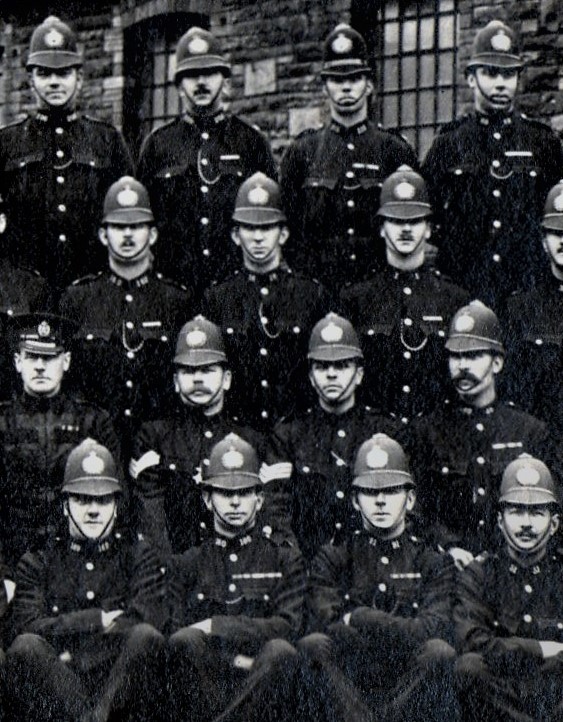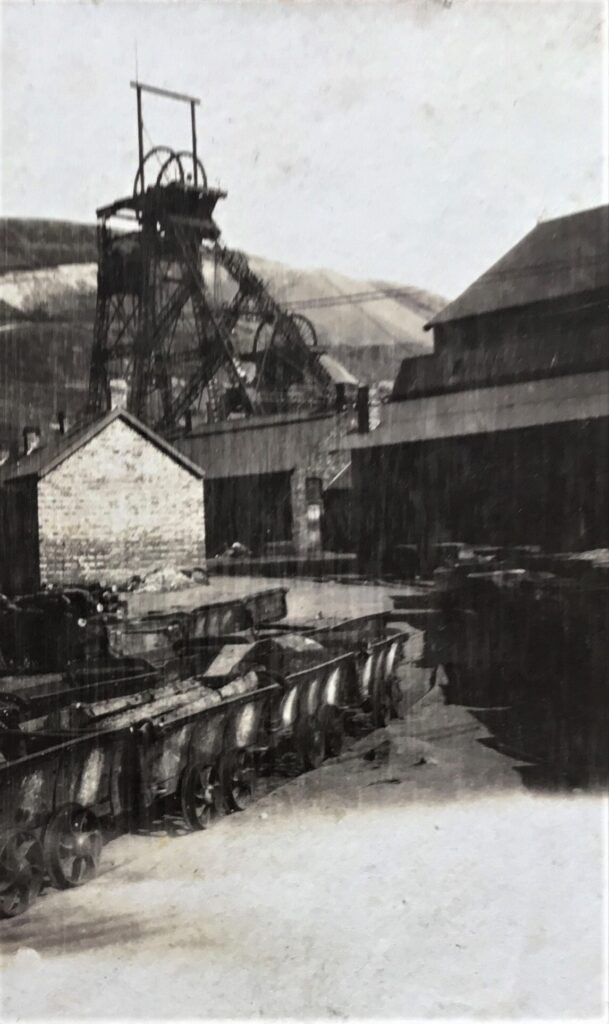
This is a postcard taken in Tonypandy, Wales in 1921 obviously ! I do not know the exact date, but I think I started trying to work out who they all were about 2015, so 7 years later with the help of the 1921 census I might be able to identify all the 50 officers.
Early on in 2015, I identified several officers, with the help of other photographs and their career path in the case of the senior officers. These were:
Supt Alfred BARRETT, 5th sitting 2nd row
Insp William WHITE, 6th sitting 2nd row
Sgt William RICHARDSON 1st Sgt, 3rd sitting 2nd row
Sgt Reginald KENT 2nd Sgt, 4th sitting 2nd row
Sgt Frank SYMES 3rd Sgt, 7th sitting 2nd row
The other Sgt sitting 8th on the 2nd row was a mystery.
The Constables I could ID were:
PC 150 Harry LILL, 2nd standing in the 3rd row.
PC 35 Henry FORSEY, 11th on the front row
PC 143 Wilfred LOCKYER, 5th on the front row
PC 81 Herbert PAULLEY, 4th standing in the 3rd row.
The Other 41 officers I could take a good guess at, but I could not prove.
The only other information I had was, that my great Uncle Cecil was not involved and an article in the Western Gazzette published on Friday 15th July 1921. The short article reported that the 4 Sherborne Division officer had returned to the town on monday 11th July after being away for 9 weeks. Those officers were Supt BARRETT and PC’s RAWLINGS, HEGGS AND CRABBE.
That meant they must have left Dorset on Monday 9th May 1921 or close to it.
Now with access to the 1921 Census and the help of David ANDREWS, we have established a list of the other officers who must be in the photograph.
Sgt Cornelius BROWN.
PC 101 William Reginald LONG
PC 115 Fred FRANKLIN
PC 91 Reuben Wiliam BOWRING
PC 45 Walter Edward TOLLEY
PC 170 Alfred George DURANT
PC 32 James Thomas WOODMAN
PC 158 George Raymond CHARLTON
PC 86 William Frank HOPKINS
PC 179 Hubert Charles SCREEN
PC 11 Sidney William MAYO
PC 159 Ernest Sidney GRANT
PC 206 Joseph CRITCHELL
PC 211 Albert BAILEY
PC 51 Robert NOTLEY
PC 61 Basil JAY
PC 205 Edward BRIDLE
PC 1 Oscar SIMS
PC 40 William GUPPY
PC 111 Albert FRIPP
PC 28 Sidney BARTLETT
PC 169 Thomas ELLERY
PC 180 Alfred CHASE
PC 85 Robert CARTER
PC 137 William TOLLEY
PC 176 Edwin BEST
PC 162 Arthur YOUNG
PC 127 Percy COPP
PC 155 Alfred WICKENS
PC 68 William BRICKELL
PC 3 Barry DIXON
PC 124 Horace COOPER
PC 202 Tom DAVIS
PC 188 James HEGGS
PC 8 Walter BLEATHMAN
PC 139 Frederick BURROUGH
PC 164 Robert BOOL
PC 113 Frank BARNES
PC 79 Edmund CRABBE
PC 16 Albert JAMES
PC 129 George RAWLINGS
March 1921.
In the aftermath of the First World War, the Triple Alliance and united action in general were regarded by many trade unionists as a possible defence against the threat of wage reductions occasioned by the onset of economic depression. A complicating factor was that both the mines and railways had been controlled by the state during the war and were not immediately returned to private hands. The Coalition-Liberal Government of David Lloyd George was unwilling to impose wage reductions, as this would provoke strike action against the government, with political implications. Reductions for miners were therefore postponed until the mines were de-controlled on 31 March 1921. Miners who refused to accept the reductions were locked out of employment.
The decision announced, following the imposition of the reductions, it was widely expected that the transport and rail unions would strike in support of the miners. However, on 15 April, the executives of the NTWF and NUR announced that they would not recommend strike action. One reason cited by the union leaders was that the miners’ representatives had made comments suggesting that they, themselves, were not prepared to strike against the reductions. More broadly, transport and rail union leaders accused the MFGB of expecting support from other unions but refusing to involve those unions in negotiations over the dispute. The principal seamen’s union, the National Sailors’ and Firemen’s Union held a ballot which resulted in the proposal for strike action being defeated by 59 votes.
The aftermath,despite the decision against fully-fledged strike action, transport and railworkers were ordered not to handle imported coal. Some workers were unhappy with this limited action. In Glasgow, for example, the Scottish Union of Dock Labourers broke with the policy of the Transport Workers’ Federation and called its members out on strike on 7 May. On the same day, wage reductions were imposed on merchant seamen, leading to a well-supported general strike at the docks which lasted for over a month. Transport and rail leaders were widely criticised for their actions, with J. H. Thomas of the NUR and Robert Williams of the NTWF being singled out for particular criticism. For their part, union leaders pointed to the difficulties of resisting wage reductions in a period of unemployment, alleged that there was little support for sympathy action amongst rank-and-file dockers and railwaymen and argued that the involvement of other workers would only lead to needless sacrifices on their part.[citation needed] In 1925, when the government agreed to grant a temporary subsidy to the mining industry so as to avoid wage reductions, the day on which the decision was announced became known as Red Friday, in imitation of Black Friday
Black Friday
A further cause of tension was the threat of the mine owners to impose pay cuts and increase working hours when the coalmines were returned to private ownership and out of government control on 31 March 1921. The miners were told they had to accept the new conditions or lose their jobs. They called on the railwaymen and transport workers to join them in a strike starting on 15 April 1921. Together these three unions formed the Triple Alliance.
The railwaymen and transport workers felt that the miners had not tried hard enough to negotiate. On the day the strike was supposed to begin they withdrew their support. This became known as ‘Black Friday’, and although the miners continued with a bitter strike they were eventually forced back to work after accepting a wage cut.
The Dorset Contingent had very little to do and saw no action , compared to the officers that were dispatched to Wales in 1926. See my seperate posts for 1926 and 1912.
Below is my latest attempt at identifying the 50 Dorset officers.

| FRONT ROW | SAT ON GROUND | ||
| 1 | PC 111 | ALBERT | FRIPP |
| 2 | PC 129 | GEORGE | RAWLINGS |
| 3 | PC 101 | WILLIAM | LONG |
| 4 | PC 179 | HUBERT | SCREEN |
| 5 | PC 143 | WILFRED | LOCKYER |
| 6 | PC 164 | ROBERT | BOOL |
| 7 | PC 169 ? | TOM | ELLERY |
| 8 | PC 180 | ALFRED | CHASE |
| 9 | PC 91 | REUBEN | BOWRING |
| 10 | PC 51 | ROBERT | NOTLEY |
| 11 | PC 35 | HENRY | FORSEY |
| 12 | PC 211 | ALBERT | BAILEY |
| SECOND ROW | SAT ON CHAIRS | ||
| 1 | PC 11 | SIDNEY | MAYO |
| 2 | PC 8 | WALTER | BLEATHMAN |
| 3 | SGT | WILLIAM | RICHARDSON |
| 4 | SGT | REGINALD | KENT |
| 5 | SUPT | ALFRED | BARRETT |
| 6 | INSP | WILLIAM | WHITE |
| 7 | SGT | FRANK | SYMES |
| 8 | SGT | CORNELIUS | BROWN |
| 9 | PC 40 | WILLIAM | GUPPY |
| 10 | PC 127 | PERCY | COPP |
| 11 | PC 61 | BASIL | JAY |
| THIRD ROW | STANDING | ||
| 1 | PC 124 ? | HORACE | COOPER |
| 2 | PC 150 | HARRY | LILL |
| 3 | PC 85 | ROBERT | CARTER |
| 4 | PC 81 | HERBERT | PAULLEY |
| 5 | PC 139 | FREDERICK | BURROUGH |
| 6 | PC 113 | FRANK | BARNES |
| 7 | PC 202 | TOM | DAVIS |
| 8 | PC 162 | ARTHUR | YOUNG |
| 9 | PC 16 | ALBERT | JAMES |
| 10 | PC 1 | OSCAR | SIMS |
| 11 | PC 3 | BARRY | DIXON |
| 12 | PC 28 | SYDNEY | BARTLETT |
| 13 | PC 32 | JAMES | WOODMAN |
| FOURTH TOP ROW | STANDING | ||
| 1 | PC 188 ?? | JAMES | HEGGS |
| 2 | PC 170 | ALFRED | DURRANT |
| 3 | PC 137 | WILLIAM | TOLLEY |
| 4 | PC 159 | GRANT | ERNEST |
| 5 | PC 45 | WALTER | TOLLEY |
| 6 | PC 79 | EDMUND | CRABBE |
| 7 | PC 86 | WILLIAM | HOPKINS |
| 8 | PC 206 | CHARLES | CRITCHELL |
| 9 | PC 209 | EDWARD | BRIDLE |
| 10 | PC 115 ?? | FRED | FRANKLIN |
| 11 | PC 68 | WILLIAM | BRICKELL |
| 12 | PC 176 | EDWIN | BEST |
| 13 | PC 151 ?? | ALFRED | WICKENS |
| 14 | PC 158 ?? | GEORGE | CHARLTON |
To make the images a bit larger and easier to see, here is another way of identifying who is who by splitting the photograph into 4 sections!

The 12 officers above from top to bottom, left to right are: HEGGS ?, DURRANT, William TOLLEY, GRANT, COOPER? LILL, CARTER, MAYO, BLEATHMAN, FRIPP, RAWLINGS and LONG.

The 13 above are: Walter TOLLEY, CRABBE, HOPKINS ,PAULLEY, BURROUGHS, BARNES, DAVIS, RICHARDSON, KENT, BARRETT, SCREEN, LOCKYER and BOOL.

The above 15 are: CRITCHELL, BRIDLE, FRANKLIN ? BRICKELL, YOUNG, JAMES, SIMS, WHITE, SYMES, BROWN, GUPPY, ELLERY ? CHASE, BOWRING and NOTLEY.

The final 10 are: BEST, WICKENS? CHARLTON? DIXON, BARTLETT, WOODMAN, COPP, JAY, FORSEY and BAILEY.
The below photograph is of PC Ernie GRANT and probably PC William BRICKELL next to him. I am guessing BRICKELL from the main photograph, so I maybe wrong. The photo of Ernie and the next one of the mine area are from Ernie’s grandson Dave GRANT and must be from the same time as have the same number stamp on the back.

